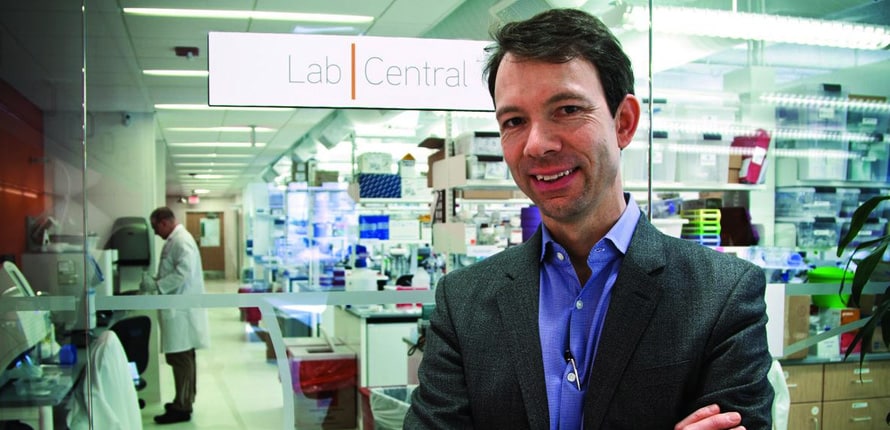Dr. Johannes Fruehauf, CEO of Biolabs and Executive Director of Lab Central
What is an innovation community? It is a mix of things: places, events, multiple stakeholder groups that interact informally yet efficiently, and that often develop a distinct culture or code of behavior in which innovation is encouraged and facilitated.
Innovation communities exist in various sizes, beginning with small units (like departments within universities, companies), larger units (incubators aggregating multiple startup companies) or large geographic clusters like Kendall Square in Cambridge or Silicon Valley.
I run LabCentral, the largest co-working facility and startup community for biotech companies in the US. It is located in Kendall Square and we currently provide shared laboratory and office co-working space for up to 70 life science companies from as little as one person to over 50 employees in size. LabCentral was built in 2014 through a public-private partnership and has been called the most successful investment the Massachusetts Life Sciences Center (MLSC) ever made. As of 2016, the initial investment of $5m of state support had been leveraged to create over 700 high paying jobs and enabled over $1bn of venture capital investment into the companies incubated here.
The secrets to this success are many – luck and good timing certainly are important. But there are others that can be derived and adopted elsewhere. The biggest among those is focus on excellence. When designing new spaces, we build and equip them for the top 10% of innovators in each of our cities. We ask and listen to these highly successful entrepreneurs and build fully functional and equipped facilities to enable their work. Once we attract these top players, the rest will follow.
The second key feature is our focus on community. We see ourselves as curators of innovation communities – not as estate providers. The facilities and infrastructure, the nice lab equipment and operational support, they are all tools to build a successful community, not the other way around.
When we build a new site, we have a mantra to ‘minimize friction & increase collisions’ – this is based on Tony Hsieh’s concept of valuable collisions (Tony is the founder of Zappos and advocate for entrepreneurs).
Minimize friction: We strive to streamline people’s work flow in our spaces, so they are never held back by any hardware elements (such as equipment downtime, lacking permits) yet we seek to increase the likelihood of ‘collisions’ between people: we plan traffic to converge in strategic areas of our facilities, we work with architecture and design elements as well as specific furniture to create natural congregation spaces. The outcome of these collisions is necessarily open-ended, but we believe that by multiplying the likelihood of collisions we make good things happen.
We often describe the two elements that define our spaces in the terms of hardware and software. While the labs and offices, conference rooms and equipment are the hardware, the many things we do to fill these places with life and curate our innovation community are the software.
The hardware part is relatively easy and is being copied now in many places around the world. You need the right balance of spaces and capital for the equipment. The software part is trickier. We start by being selective. We look for quality science and strong business plans, we prioritize enthusiastic and experienced teams, but we also put a lot of emphasis on the right attitude towards the other – our spaces work well because people are open and collaborative.
A shared sense of responsibility and ‘citizenship’ helps us create a unique experience and culture. Mentorship then develops naturally. Competition is optimistic and spirited, not mean. Successes and milestones achieved are celebrated by all. Our staff is trained with a service attitude and we hold many events to teach valuable content. Each of those again has the dual purpose of teaching and personal engagement.
In a well-functioning innovation community, innovators will thrive because non-productive friction is minimized, and they have access to necessary resources without losing sight of their work.
A working innovation ecosystem will contain the essential elements of a diverse talent pool, readily accessible capital, supportive policies and an attitude that recognizes failure as an opportunity for learning.
As policymakers think about how to best enable their young populations to participate, assembling these elements can help with jumpstarting a successful innovation economy.
Some interventions will have to do with creating buildings and physical resources, others have to do with policy and public investment and framing of the discussion. Clear policies for transfer of intellectual property make lower investment risk and can attract venture capital. A well-managed seed fund vehicle can help jump-start innovation businesses and retain talent, and a welcoming immigration policy will allow qualified workers to migrate to the new hub and create value.
In successful geographic innovation clusters, many of the elements we use at the local level are visible and active and have developed naturally. Studying the current status quo in light of these observations may help decision makers identify where the most impactful intervention can be made to maximize impact – with the goal to create an environment in which entrepreneurs strive and innovation is more efficiently translated into societal benefit.
Creating innovation communities to accelerate idea development
February 21, 2018
